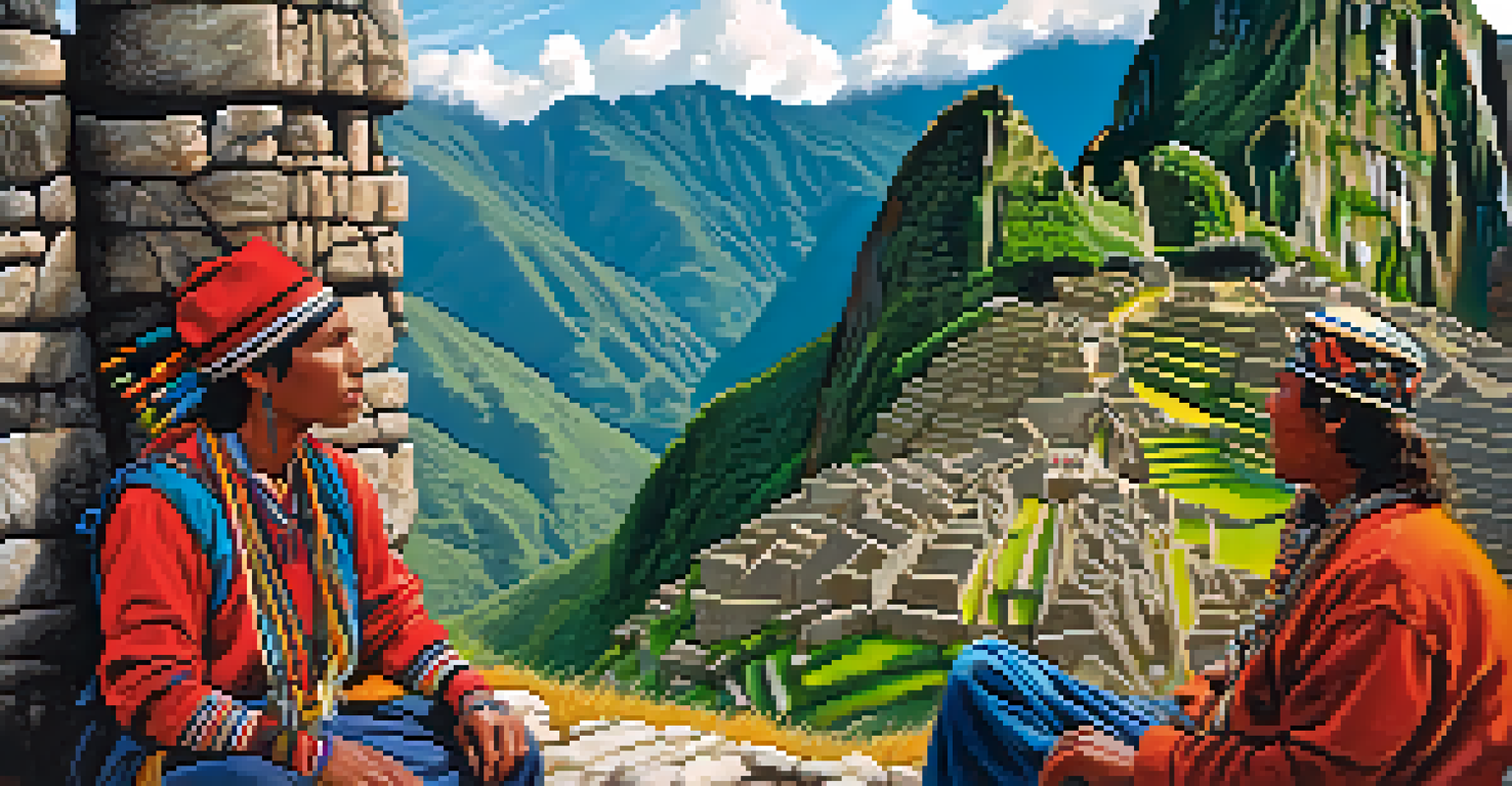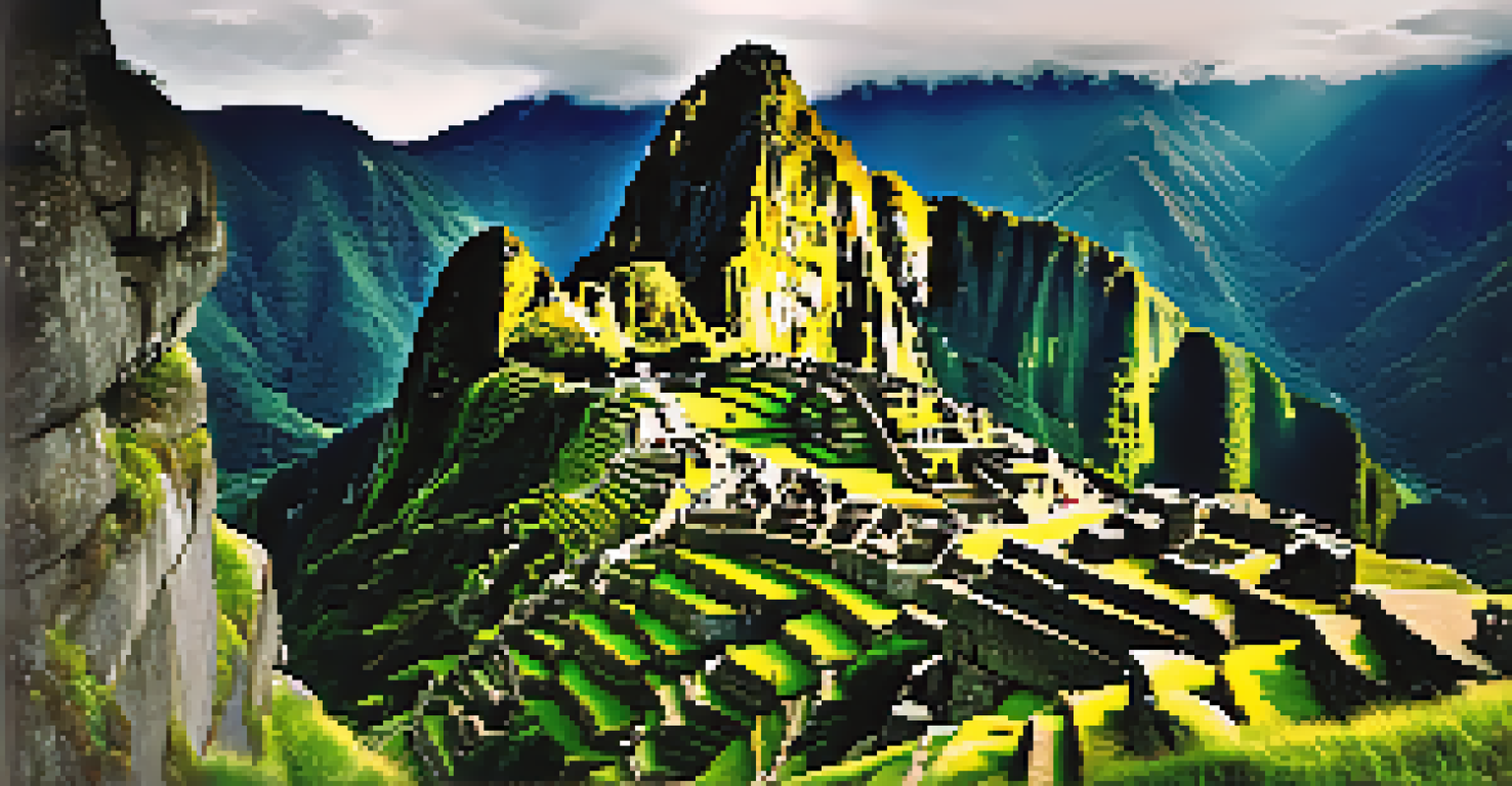Exploring the Inca Trail: A Key Historical Route in Peru

The Significance of the Inca Trail in History
The Inca Trail is not just a scenic trek; it holds immense historical significance. This ancient path served as a vital connection between various regions of the Inca Empire, facilitating trade, communication, and military movement. Walking this trail today, you can almost feel the footsteps of those who traveled it centuries ago, experiencing the same breathtaking landscapes and vibrant ecosystems.
The journey of a thousand miles begins with one step.
Inca society was deeply intertwined with the natural world, and the trail reflects this connection. Along the route, trekkers can encounter numerous archaeological sites, including temples, agricultural terraces, and ruins that showcase the ingenuity of the Incas. Each stop along the way tells a story, connecting visitors to the rich tapestry of Inca history and culture.
Moreover, exploring the Inca Trail allows one to grasp the scale and sophistication of the Inca civilization. It’s a testament to their engineering prowess and understanding of the Andean environment, making the journey not just physically rewarding but also intellectually enriching.
Preparing for Your Inca Trail Adventure
Preparation is key when it comes to hiking the Inca Trail. First, it's essential to secure permits well in advance, as they are limited and often sell out quickly. Planning your trip months ahead will not only ensure you get a spot but also give you ample time to gear up for the trek, both physically and mentally.

Packing wisely is crucial for a successful hike. Lightweight clothing, good hiking boots, and quality gear will make a significant difference in your comfort level on the trail. Don't forget essentials like sunscreen, a reusable water bottle, and snacks to keep your energy up as you navigate the beautiful Andean landscape.
Historical Significance of the Trail
The Inca Trail served as a vital connection for trade, communication, and military movement within the Inca Empire, rich with archaeological sites that narrate its storied past.
Lastly, consider the physical demands of the trail. A few weeks of regular exercise, including cardio and strength training, can help prepare your body for the altitude and the challenging terrain. Remember, this journey is as much about the experience as it is about the destination, so being in good shape will enhance your enjoyment of the breathtaking views.
The Diverse Ecosystems Along the Trail
One of the most fascinating aspects of the Inca Trail is the diversity of ecosystems it encompasses. From lush cloud forests to arid mountain landscapes, each section of the trail offers unique flora and fauna. This variety not only enriches the hiking experience but also provides insight into the ecological significance of the region.
In every walk with nature one receives far more than he seeks.
As you trek, you may encounter vibrant orchids, towering trees, and even unique wildlife like the Andean condor. The changing landscapes also reflect the ancient Inca's deep respect for nature, as they adapted their agricultural practices to suit the varying environments found along the trail. This connection to nature is palpable, immersing trekkers in the beauty of the Andes.
Exploring these ecosystems can be a humbling experience, reminding us of the delicate balance between human activity and the natural world. Observing how the Incas harmonized their lives with their surroundings can inspire modern travelers to reflect on their relationship with nature, making the hike not just an adventure but a journey of self-discovery.
Cultural Encounters on the Inca Trail
Hiking the Inca Trail is not just about the stunning views; it's also an opportunity to connect with local cultures. Along the way, trekkers may meet indigenous communities who maintain their traditions and ways of life, offering a glimpse into the rich cultural tapestry of Peru. Engaging with these communities can enhance your understanding of the region's history and present.
Many local guides share fascinating stories about their ancestors, the Incas, and their connection to the land. This firsthand knowledge provides context to the archaeological sites you encounter and deepens your appreciation for the Inca civilization. It's a reminder that history is not just about the past; it's alive in the stories and practices of people today.
Preparation is Essential for Hikers
Proper planning, including securing permits and physical conditioning, is crucial to ensure a successful and enjoyable hiking experience on the challenging Inca Trail.
Don't miss the chance to sample traditional Andean dishes prepared by local cooks. These culinary experiences can be a delicious way to immerse yourself in the culture, making every meal a celebration of the region's heritage. Such encounters create lasting memories, enriching your journey along the Inca Trail.
The Challenge of the Inca Trail
The Inca Trail is renowned for its challenging terrain, making it a thrilling adventure for hikers. With steep ascents, rocky paths, and high altitudes, it's essential to be prepared for a physical test. However, the sense of accomplishment that comes from reaching the summit and witnessing the iconic Machu Picchu is truly unmatched.
Many trekkers find that the challenges of the trail foster camaraderie among fellow hikers. Sharing the experience of tackling difficult sections can create bonds that last beyond the hike. Whether it's helping each other over rocky sections or celebrating at the end of a long day, these shared challenges enhance the journey.
Additionally, embracing the challenges of the Inca Trail can lead to personal growth. Overcoming obstacles, both physical and mental, can instill a sense of confidence and resilience. As you navigate the trail, you'll not only be conquering nature but also discovering your own capabilities along the way.
Reaching Machu Picchu: The Ultimate Reward
After days of hiking, the moment of reaching Machu Picchu is nothing short of magical. As the ruins emerge from the morning mist, it's as if you've stepped back in time to the heart of the Inca Empire. This UNESCO World Heritage Site stands as a testament to the ingenuity and spirit of the Incas, leaving visitors in awe of its beauty and historical significance.
Exploring Machu Picchu is an experience that transcends mere sightseeing. Each corner of the site holds stories of its past, from the agricultural terraces to the ceremonial temples. Taking the time to wander through the ruins allows you to appreciate the incredible architectural feats achieved by the Incas, as well as their deep connection to the land.
Preserving the Trail's Legacy
Sustainable tourism practices and engagement with local conservation initiatives are vital to protect the Inca Trail's ecosystems and cultural heritage for future generations.
Moreover, the sense of accomplishment that comes from completing the Inca Trail enhances the experience of visiting Machu Picchu. You’ll find that every step you took along the trail was worth it when you finally arrive at this iconic destination, making it a highlight of your journey. This culmination of adventure and history is an unforgettable moment that lingers in the heart long after the trip ends.
Preserving the Inca Trail for Future Generations
As more travelers flock to the Inca Trail, the importance of preserving this historical route becomes paramount. Sustainable tourism practices are essential to protect the delicate ecosystems and cultural heritage that make this journey so special. By being mindful of our impact, we can ensure that future generations can also experience the magic of the Inca Trail.
Travelers can contribute to preservation efforts by following the principles of Leave No Trace. This means respecting the environment, staying on designated paths, and minimizing waste. By adopting these practices, we can help safeguard the beauty and integrity of the trail, allowing it to remain a cherished destination for years to come.

Engaging with local conservation initiatives is another way to support the preservation of this incredible route. Many organizations work tirelessly to protect the Inca Trail and its surroundings, and travelers can often contribute through volunteering or donations. By supporting these efforts, you’re not just enjoying a trek; you’re playing a part in preserving history and nature for future adventurers.